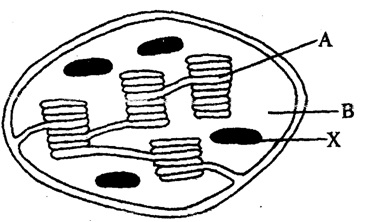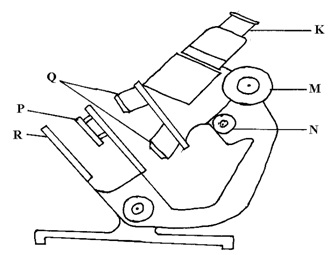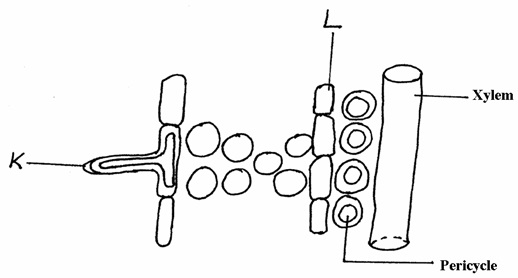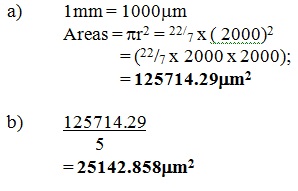Question 1
The diagram below represents a plant cell organelle.

a) Name the organelle.
b) In which of the labelled parts does carbon (IV) Oxide fixation occur?
c) Name the parts labelled A and B and state how each is adapted to its functions.
A ...........
B ...........
d) Explain what would have happened to the structures labelled X had the plant been kept in darkness for 48 hours.
Answer
a) Chloroplast
b) B
c)
A - Grana: contain chlorophyll, which traps light energy ,enabling light reaction of photosynthesis to take place
B - Stroma: contains enzyme, which control dark reactions of photosynthesis
d) They would be absent because starch they contain would have been hydrolysis to glucose
b) B
c)
A - Grana: contain chlorophyll, which traps light energy ,enabling light reaction of photosynthesis to take place
B - Stroma: contains enzyme, which control dark reactions of photosynthesis
d) They would be absent because starch they contain would have been hydrolysis to glucose
Question 2
The diagram below shows some components of a light microscope.

a) Name the parts labelled K and M
b) State the functions of P and Q
c) A student was viewing a prepared slide of a plant cell under high power microscope. The features of the cell were blurred. Which one of the labelled parts of the microscope would the student use to obtain a sharper outline of the features.
d) Give the formula used to calculate magnification in a light microscope.
Answer
a) K - eye piece and M - coarse adjustment knob
b) P-concentrate the light/focuses the light and Q- magnification of the image.
c) N
d) Eyepiece magnification X objective lens magnification
b) P-concentrate the light/focuses the light and Q- magnification of the image.
c) N
d) Eyepiece magnification X objective lens magnification
Question 3
A student was preparing a section of a plant cell to be viewed on a light microscope. Give a reason for each of the following steps:-
(i) Cutting a very thin section
(ii) Staining the section
(iii) Putting the section in water
Answer
i) For light to pass through easily
ii) To make the features more clear and distinguishable
iii) For cells to remain turgid
ii) To make the features more clear and distinguishable
iii) For cells to remain turgid
Question 4
The diagram below shows part of a longitudinal section of a root.

(a) Identify cells K and L
(b) State two adaptations of Cell K to its functions
Answer
(a) K – Root hair cell and L – Endodermis
(b) Elongated to increase area for absorption of water and mineral salts
(b) Elongated to increase area for absorption of water and mineral salts
Question 5
State three main functions of the stomach in human beings:-
Answer
(i) Temporary storage of food
(ii) Secretes digestive enzyme
(iii) Secretes mucus - gastric juice
(iv) Secretes Hcl - Endocrine function i.e. Gastrin hormone
(ii) Secretes digestive enzyme
(iii) Secretes mucus - gastric juice
(iv) Secretes Hcl - Endocrine function i.e. Gastrin hormone
Question 6
Name the cell organelles responsible for:
i) Protein synthesis
ii) Destroying worn – out organelles and cells
Answer
i) Ribosomes
ii) Lysosomes
ii) Lysosomes
Question 7
Mateo school biology student used a microscope with x40 objective lens and x5 eye piece lens which had 2mm radius.
a) Calculate the area of the field of view in micrometers.
b) What is the average size of the cell in micrometers?
Answer

Question 8

a) Identify the organelle shown above
b) How is the organelle you have identified in (a) above suited to its function
Answer
a) mitochondria
b)
- Has cristae/inner membrane highly folded to increase surface area; for respiration.
- Has matrix medium for respiratory activities
- Has matrix medium for respiratory activities
b)
- Has cristae/inner membrane highly folded to increase surface area; for respiration.
- Has matrix medium for respiratory activities
- Has matrix medium for respiratory activities
Question 9
State three properties of the cell membrane:
Answer
- Sensitive to change in temp
- Sensitive to changes in PH
- Has both negative and positive charges
- Sensitive to changes in PH
- Has both negative and positive charges
Question 10
What is the formula for calculating linear magnification of a specimen when using a hand lens?
Answer
Length of drawing ÷ Length of object
Question 11
Distinguish between the following terms:
a) Magnification and resolution of a microscope
b) Mounting and staining of a specimen
Answer
a) Magnification is the ability of a microscope to enlarge tiny objects while resolution is the ability of a microscope to separate between two tiny structures under magnification to appear distinct
b) Mounting is the placing of prepared slide on stage of a microscope while staining is the use of chemical stain on specimen for clear observation
b) Mounting is the placing of prepared slide on stage of a microscope while staining is the use of chemical stain on specimen for clear observation
Question 12
Name the organelle that performs each of the following functions in a cell.
(a) Transport of packaged glycoproteins
(b) Destruction of worn out cell organelles
(c) Synthesis of proteins
Answer
(a) Golgi bodies/Golgi apparatus
(b) Lysosome(s)
(c) Ribosomes
(b) Lysosome(s)
(c) Ribosomes
Question 13
Why are the following procedures done when preparing sections to be observed under a light microscope?
(a) Making of thin sections
(b) Using a sharp blade to make the sections
(c) Staining
Answer
(a) Make the sections transparent
(b) To produce thin sections/ Not to distort the cells
(c) To distinguish between different parts/organelles of the cells
(b) To produce thin sections/ Not to distort the cells
(c) To distinguish between different parts/organelles of the cells
Question 14
State three physiological processes that are involved in movement of substances a cross the cell membrane:
Answer
- Diffusion
- Osmosis
- Active transport
- Osmosis
- Active transport
Question 15
Name the diseases caused by deficiency of (a) Iodine and (b) Vitamin C;
Answer
a) Goitre / Goiter
b) Scurvy
b) Scurvy
Question 16
What are the two functions of bile salts during the process of digestion?
Answer
- To emulsify fats
- To provide an alkaline condition for enzyme activities
- To provide an alkaline condition for enzyme activities
- To provide an alkaline condition for enzyme activities
- To provide an alkaline condition for enzyme activities
Question 17
State two adaptations of herbivores which enable them to digest cellulose
Answer
- Long gut / many chambers to provide large surface area for digestion
- Bacteria in rumen has enzyme cellulase which digest cellulose (to glucose/ sugars)
- Bacteria in rumen has enzyme cellulase which digest cellulose (to glucose/ sugars)
Question 18
State three factors that affect the rate of osmosis
Answer
- Concentrated of the solutions separated by a semi-permeable membrane
- Existence of concentration gradient
- Temperature of the solution
- Existence of concentration gradient
- Temperature of the solution
Question 19
State three roles of light in photosynthesis
Answer
- Photolysis (Splitting water into H+ and oxygen gas)
- Synthesis of ATP to be used during dark stage
- Synthesis of chlorophyll necessary for photosynthesis
- Synthesis of ATP to be used during dark stage
- Synthesis of chlorophyll necessary for photosynthesis
Question 20
Explain how saliva is important in digestion
Answer
- Enzymes amylase digests starch to maltose
- Mucus lubricates food
- Mucus lubricates food
Question 21
Briefly explain the fate of the following products from the light stage of the process of Photosynthesis
(a) Oxygen
(b) Hydrogen
(c) ATP
Answer
a) Oxygen- releases to the atmosphere or used by plants for respiration
b) Hydrogen- enter dark stage, where it combines with CO2 to form simple sugar
c) ATP- provide energy during the combination of hydrogen a toms with CO2 in dark stage
b) Hydrogen- enter dark stage, where it combines with CO2 to form simple sugar
c) ATP- provide energy during the combination of hydrogen a toms with CO2 in dark stage
Question 22
State three ways by which plants compensate for lack of the ability to move from one place to another
Answer
- Plants are able to synthesize their own food
- Plants are able to use pollination rather than moving to seek mating partners
- Use seed and fruits dispersal to colonize new habitats
- Plants are able to use pollination rather than moving to seek mating partners
- Use seed and fruits dispersal to colonize new habitats
Question 23
State four difference between monosaccharides and polysaccharides
Answer
| Monosaccharides | Polysaccharides |
|---|---|
| Are soluble in water | Are insoluble in water |
| Form sweet tasting solution | Do not have a sweet taste |
| Reduce Copper(II) ions in benedicts solution toCopper (I) ions when heated together | They do not reduce |
| Are crystallizable | Are not crystallizable |
Question 24
Describe how mammalian small intestine is adapted to its function:
Answer
- Intestines are relatively long/coiled /folded allowing food enough time for absorption
- Intestines have villi to increase the surface area for absorption and digestion
- The walls have glands which secrete enzymes for digestion (e.g. Maltose, sucrose lactose etc). Some glands /goblet cells also produce mucus which protects the intestinal wall from autodigestion/being digested; and reduce friction
- Intestines have opening of ducts which allows bile pancreatic juice into the lumen
- The intestines have circular and longitudinal muscle, whose contraction and relaxation/peristalsis
- Leads to mixing of food with enzymes/juice, facilitating rapid digestion and help push food along the gut
- The intestines are well supplied with blood vessels to supply oxygen/ remove digested food from an efficient absorption and transporting system to move the food away from the small intestines
- Have lacteal vessels for transport of fat/lipid and have thin epithelial lining to facilitating fast absorption /diffusion;
- Intestines have villi to increase the surface area for absorption and digestion
- The walls have glands which secrete enzymes for digestion (e.g. Maltose, sucrose lactose etc). Some glands /goblet cells also produce mucus which protects the intestinal wall from autodigestion/being digested; and reduce friction
- Intestines have opening of ducts which allows bile pancreatic juice into the lumen
- The intestines have circular and longitudinal muscle, whose contraction and relaxation/peristalsis
- Leads to mixing of food with enzymes/juice, facilitating rapid digestion and help push food along the gut
- The intestines are well supplied with blood vessels to supply oxygen/ remove digested food from an efficient absorption and transporting system to move the food away from the small intestines
- Have lacteal vessels for transport of fat/lipid and have thin epithelial lining to facilitating fast absorption /diffusion;
